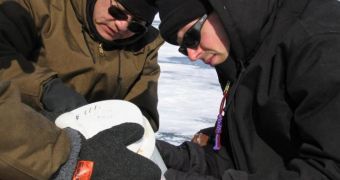Scientists say that Vikings settlers which occupied Greenland were severely affected by climate change thousands of years ago. The changes their environment suffered eventually led to the collapse of this population on the island.
A study conducted by researchers at the Brown University found in an accurate climate reconstruction that temperatures most likely plunged by several degrees within just a few decades. This was more than the settler could handle, and their inability to adapt eventually led to their disappearance from the area.
Their reconstruction covers more than 5,600 years of climate history, and was focused on lakes near the Norse settlement in western Greenland. These areas were inhabited by Vikings for many years.
In addition to the Norse culture, the Dorset and Saqqaq cultures were equally affected by the changing climate, which caught all of these people on the wrong foot. Vikings disappeared entirely from Greenland by the 14th and early 15th centuries.
Experts are convinced that they will not be able to determine what led to this disappearance in detail. However, they can fill in some of the blanks, and the new analysis does just that. Details of the work appear in the latest issue of the esteemed journal Proceedings of the National Academy of Sciences.
Starting in the 1400s, Europe and Greenland were affected by what was called the Little Ice Age, a period of cooling that dropped average temperatures considerably. The event also led to the collapse of agriculture and other food supplies at many locations.
In order to arrive at these conclusions, researchers investigated two lakes in Kangerlussuaq, which is where the Norse culture had built its Western Settlement. “This is the first quantitative temperature record from the area they were living in,” William D’Andrea explains.
“So we can say there is a definite cooling trend in the region right before the Norse disappear,” adds the expert, who is a PhD geological scientist from Brown now based at the University of Massachusetts–Amherst.
“The record shows how quickly temperature changed in the region and by how much. It is interesting to consider how rapid climate change may have impacted past societies, particularly in light of the rapid changes taking place today,” adds study coauthor Yongsong Huang.
The expert, who is a professor of geological sciences at Brown, was also the principal investigator of the research project, as well as D’Andrea’s PhD adviser. The investigation was funded by the US National Science Foundation (NSF).
When Vikings first arrived in Greenland, in the 980s, they found a climate that was very similar to the one the island has today. As such, they built two groups of villages, called the Eastern and Western Settlements.
However, for 80 years in the 1100s, temperatures dropped constantly, by as much 4 degrees Celsius (7 degrees Fahrenheit) from initial levels. The pressure this event exerted may have wiped out the Viking population in the area, experts say.
“You have an interval when the summers are long and balmy and you build up the size of your farm, and then suddenly year after year, you go into this cooling trend, and the summers are getting shorter and colder and you can’t make as much hay,” D'Andrea explains.
“You can imagine how that particular lifestyle may not be able to make it,” the expert concludes.

 14 DAY TRIAL //
14 DAY TRIAL //